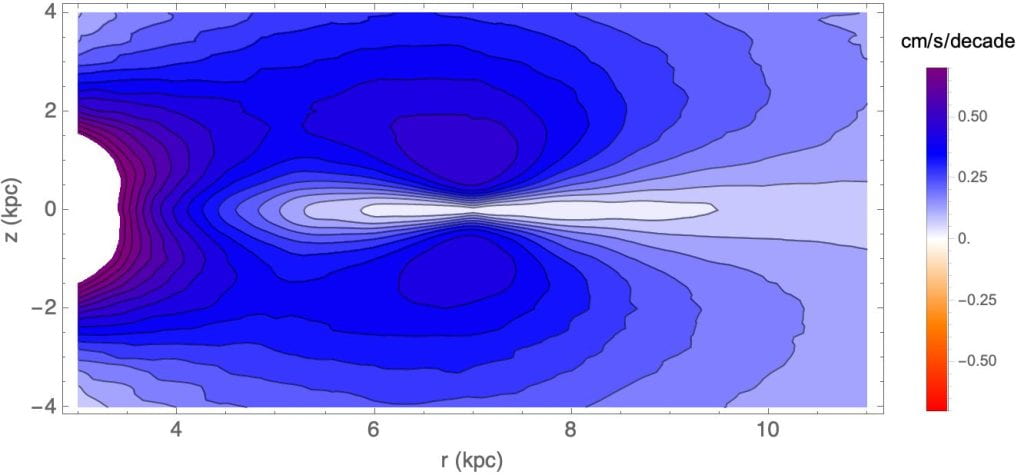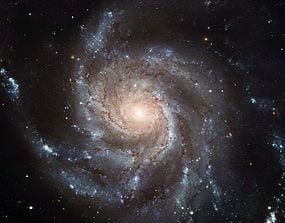 For astronomers, looking at the sky can be like watching an unfamiliar sport on TV. We can’t make sense of what we see, but is it because we don’t know the rules, or that we can’t see all the players? (Or, worst case, we can’t see the players and we don’t know the rules) For us, the players are the stars, and our best guess for the rules is the laws of motion and gravity Newton wrote down around 350 years ago.*
For astronomers, looking at the sky can be like watching an unfamiliar sport on TV. We can’t make sense of what we see, but is it because we don’t know the rules, or that we can’t see all the players? (Or, worst case, we can’t see the players and we don’t know the rules) For us, the players are the stars, and our best guess for the rules is the laws of motion and gravity Newton wrote down around 350 years ago.*
Our own Milky Way is a galaxy, a huge collection of stars, and there are billions of galaxies distributed throughout the visible Universe. But if each galaxy is a game, Newton’s rules do not let us make sense of the action: the stars within galaxies move much too fast for the collective gravitational fields of the stars within each galaxy to be strong enough to hold them together.
Two solutions are possible. If there are large quantities of dark matter in each galaxy, in addition to the stars, the gravitational field of this additional ingredient let us make sense of what we see. Alternatively, if gravity works differently at the huge distances from the way it behaves on earth or in our solar system we might be able to manage without dark matter. Dark matter adds extra players in the game; modified gravity changes the rules.
Most (in fact, almost all) astrophysicists prefer dark matter to modified gravity. Neither is perfect: dark matter does a much better job of explaining the properties of the universe on very large scales but there are many open questions about the internal dynamics of galaxies themselves. Physicists have no idea what dark matter would be made of, but we do know that it has to be something fundamentally new. Likewise, if gravity works differently on galactic scales than it does at smaller distances, we would need a radical rethink of fundamental physics.
Part of the challenge is that we can’t directly measure the gravitational force exerted on a single star by everything else in the galaxy. Newton’s Second Law, “F=ma” tells us that force is proportional to acceleration. Stars move very quickly (the sun travels at 220 km/s relative to the galaxy as a whole; 300 times faster than a speeding bullet) but accelerate – change their motion – very slowly. In roughly 100 millions years time, the sun will be on the other side of the Milky Way from where it is now, with its direction of motion reversed. But the acceleration needed to make this happen changes the sun’s velocity by less than one centimetre per second per year, roughly the speed at which an ant walks.
However, Hamish Silverwood (Barcelona) and Richard Easther (Auckland) realised that it may actually be able to detect these tiny changes over a decade, and thus measure the force exerted on individual stars by all the other mass in the galaxy. This will require measurements of stellar spectra that are accurate to better than one part in a billion or many, averaged measurements. Achieving this will require telescopes and instruments a generation beyond those now construction, so it is a project for the 2030s.
The instruments we would use to measure these tiny velocity changes are actually being developed to find planets around distant stars, and these planets may present the biggest challenge to this sort of measurement. As a planet moves in its orbit it induces a small change in the speed of the parent star, like an adult and a child on a see-saw; for an earth-like planet moving round a sun-like star, the change is a few centimetres per second per year; the signal we hope need to detect will be roughly this size after a decade of observations. A key challenge will thus be disentangling the motion induced by planets. In fact, a group based at Michigan and Harvard were simultaneously and independently working on the same idea; their work appeared together with our paper, and they looked in detail at the challenge of removing the planetary component to reveal the the underlying acceleration.
If you can directly measure the gravitational forces on stars you can answer a huge range of questions. You can directly test predictions of any imaginable modified gravity theory, which differ in their fine detail from a model of a galaxy with dark matter and Newtonian physics. Likewise, if dark matter is holding the galaxy together, the distribution of dark matter with the galaxy may be irregular on small scales, and acceleration measurements would directly map the distribution of dark matter.
None of this will happen soon – our calculations assumed a ten year baseline for the changing speeds to become apparent, and next-generation of high-precision instruments that can be attached to a brace of giant telescopes are now under construction. However, this kind of measurement is now on the radar for planners looking at the cases for building major instruments over the next ten and twenty years. On the other hand, the challenge of explaining the motion of stars within the galaxy is over 100 years old, so even if there would be a long wait before we could put them to use, it is well worth exploring the potential of novel techniques to probe the large scale properties of gravity.
This idea was the subject of a White Paper for the 2020 US Decadal Survey that looked at a wide range of approaches to “direct acceleration” measurements on both cosmological and galactic scales. In 2023 we updated this idea, building on work done by Maxwell Finan-Jenkin as part of his BSc(Hons) project at the University of Auckland, looking at the differences in the accelerations derived from Newtonian and MONDian gravity in simulated galaxies. The differences are tiny — around half a centimetre per second in velocity over a decade for these idealised scenarios, but it sets a target for future experiments.

The difference in the expected accelerations from MONDian and Newtonian gravity over the course of a decade seen from a (roughly) sun-like location in a simulated galaxy a little smaller than the Milky Way.
* We know that Einstein’s General Theory of Relativity supersedes Newton’s laws in some circumstances (including descriptions of the global behaviour of the expanding universe) but for the behaviour of stars the two theories make overlapping predictions.
Related Papers
- Inside MOND: Testing Gravity with Stellar Accelerations, Maxwell Finan-Jenkin and Richard Easther • e-Print: 2306.15939 [astro-ph.GA]
- Stellar Accelerations and the Galactic Gravitational Field, Hamish Silverwood and Richard Easther, Publ.Astron.Soc.Austral. 36 (2019) e038 • e-Print: 1812.07581 [astro-ph.GA]

